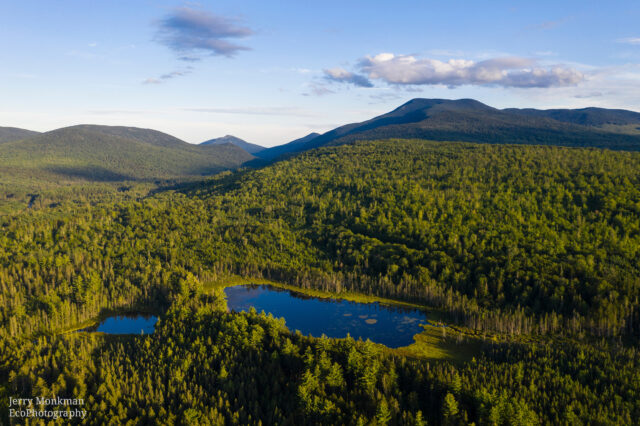Author: Katie Allen, Director of Landscape Conservation, Appalachian Trail Conservancy

An aerial view of York Pond looking towards Grafton Notch in Grafton Township, Maine.Photo by Jerry Monkman. Courtesy of the Appalachian Trail Conservancy.
From Georgia to Maine, the Appalachian Trail Conservancy (ATC) works tirelessly to protect, manage, and advocate for the Appalachian National Scenic Trail (A.T.). As the trail meanders across scenic peaks, lush valleys, deep forests, and even through several towns, it offers an unparalleled opportunity for anyone who wishes to experience the famous footpath. The Trail both challenges and inspires, leaving people changed forever.
As much as we are dedicated to the Trail, we are equally as dedicated to protecting the benefits the Trail provides through its existence as one of the largest landscape conservation projects in the United States. All life depends on conserved and connected lands, and across its 2,194 miles, the trail connects a variety of wild, scenic, and culturally significant landscapes. Understanding there are real threats to those landscapes due to climate change, forest fragmentation, and incompatible development, the ATC is committed to protecting the long-term resiliency of the Trail by ensuring these vital lands are conserved to provide clean water, clean air, thriving communities, and outdoor access for all.
This is no small feat, and it takes a coordinated, collaborative network of partners to preserve the lands that connect the landscape. In coordination with the National Park Service, the ATC oversees the Appalachian Trail Landscape Partnership (ATLP). This partnership is charged with delivering on the unfinished business of protecting resilient lands across the A.T. landscape. More than 100 partners have joined this network, which brings together additional resources and capacity to facilitate greater protection of the A.T. landscape, in turn safeguarding the experience of anyone finding themselves on the A.T. in pursuit of respite from busy cities, fresh air, and expansive views of pristine natural corridors
“The Appalachian Trail was created through partnerships, and through the work of the Appalachian Trail Landscape Partnership, collaborative land conservation continues today,” said Katie Allen, the ATC’s Director of Landscape Conservation. “Working together, we can protect the iconic values of the Appalachian Trail landscape. Those values—such as clean air and water, abundant recreational opportunities, and ties to rich cultural heritage and history—have a direct impact on the health and wellbeing of those who live, work, and play within this landscape.”
An essential part of the partnership is the ATC’s Wild East Action Fund, which provides grants to conservation partners to assist in land protection. Since its establishment in 2018, the ATC’s Wild East Action Fund has awarded almost $2 million to aid in the protection of more than 80,000 acres across 14 states. To date, the Fund has leveraged more than $80 million as conservation groups from Maine to Georgia work to conserve high-priority lands vital to a protected A.T. landscape.
In March, the ATC announced the permanent protection of 21,300 acres of land in Grafton Forest by ATLP partners in Maine. Adjacent to the Trail and serving as a link between conserved lands in Maine and New Hampshire, this landscape conservation success will increase recreational access to the A.T., essential natural resource connectivity, and will protect the Trail’s scenic beauty. An exceptional demonstration of ATLP partnership in action to support the A.T. and surrounding landscape.
The Grafton Forest Conservation Project is led by the Forest Society of Maine and Northeast Wilderness Trust, with the ATC providing essential funding through the Wild East Action Fund to help the project succeed. The Fund is made possible through the generosity of private donors, and those who contributed can share in this conservation success, knowing that the permanent protection of these lands is a direct impact of their generosity.